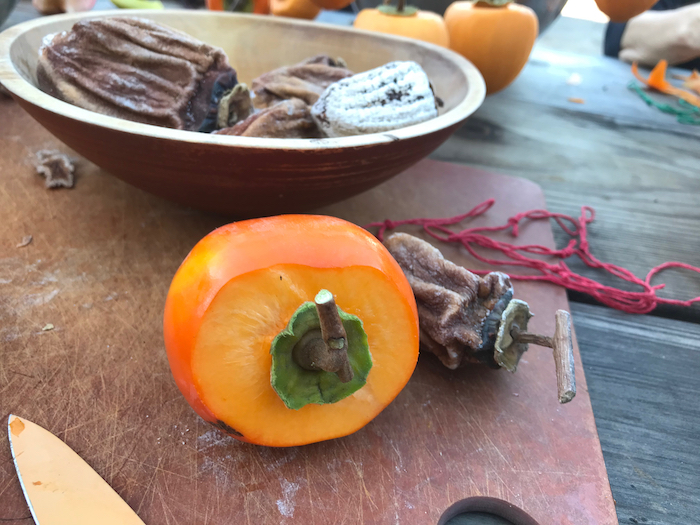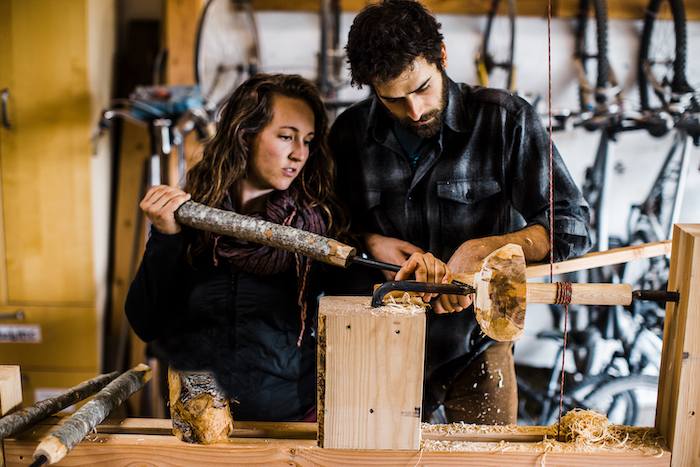Nick LaHaise, co-founder of Hearth Folk School, holds a bright orange Hachiya persimmon in front of him.
There’s a kitchen paring knife in his other hand and a vegetable peeler on the table. Lengths of twine rest in a bundle, and a long wooden rod is poised over two milk crates, waiting for us. These are all the supplies we will need to make the delicacy called hoshigaki, which simply means “dried persimmon” in Japanese. The main tools will be our hands. Villagers in Japan have made hoshigaki for many hundreds of years; the fruits are harvested before they are ripe, peeled and hung on the eaves of houses, and, over a period of weeks, delicately massaged so that the astringent fibers transform into gems of non-perishable food.
“You see where the fruit slopes below the calyx?” LaHaise points, demonstrating where to cut into the shoulders of the persimmon. With the knife he swivels a ring of vermillion skin over the stem, neatly, like a shirt eased over someone’s head. We all follow his movements with our own knives. Then we peel each fruit in downward strokes.
At first it feels awkward, and I am struck by the sensation of naked, sticky flesh that darkens my fingers. But there is no rush; we have this whole November afternoon to practice on bushels of persimmons, and soon I revel in the quiet rhythm my hands have found. We talk and pause to take bites of last year’s harvest. Completed hoshigaki are dense and jammy, coated with a frost of their own natural sugars, and often sliced thin like a fine cheese.
Sebastopol-based Hearth Folk School carries on a legacy of education that originated in Denmark in the 1800s. The Folk School vision (folkeskole, literally “people’s school”) was born out of the desire for a non-competitive education that honored place, tradition, community, and the work of the hands. Today, folk schools are found all over the world, but Hearth is one of the very first in California.
LaHaise and his fellow founder Raleigh Campbell, both craftspeople and teachers, met in the kindred world of “traditional skills gatherings,” typically held once a year, like the well-loved Buckeye Gathering. People convene for several days to live together and learn crafts and activities that were once commonplace in all cultures, but are now not practiced by the average person: woodturning, basketry, spoon-carving, friction fire, and animal tracking, just for starters.
“There is a hunger to learn these old skills,” LaHaise muses in a conversation we have during the first days of a shelter-in-place order for the coronavirus epidemic. Campbell chimes in remotely: “Traditional craft has a relationship with the land, with community, and with place, unlike the work that people, myself included, do digitally or with machines.” She observes that the slowness of working with your hands brings the body “into a state of being that many of us only experienced during childhood. It’s in our DNA, though,” she concludes optimistically.
LaHaise and Campbell were determined to make a place in Sonoma County where people could learn hand-based and earth-centered skills, which they themselves had to travel far and wide to study. In the actual pursuit of learning a skill, students are also instilled with a sense of self-reliance, and a deeper appreciation of the materials inherent in the land.
“There are so many talented craftspeople here,” LaHaise shares. “Our hope is that Hearth becomes a hub for the community.” The school website offers a great broom-making kit, and links to the online Spoon Club, where aspiring carvers can learn the spoon-carving craft from home. Several of the classes are on the ecology of our region; Hearth hosts regular series on local birds and one on snakes—which Campbell points out was their most popular class last year, people traveling from hours away to learn about creatures they have often feared.
Pole-lathe woodturning, which dates back to the 1200s, is one of the skills that students at Hearth study in concentrated two-day workshops. LaHaise tells me that the foot-pedaled craft had nearly died out in England, until a craftsman named Robin Wood wrote a book called The Wooden Bowl on the history of the art. There has since been a resurgence of pole lathe woodturning, which is physically demanding and uniquely satisfying. “You use your whole body to turn a bowl” explains LaHaise.
As we prepare to take our persimmons home and hang them up in a warm, airy place, LaHaise cheerfully shares the “horror stories” of his first hoshigaki babies. Hint: they can mold. Second hint: don’t leave them alone for a week without checking. I am aware that he is bestowing us with all the knowledge he has accumulated from teacher to teacher to teacher. But, most importantly, what he’s learned by simply doing the craft again and again. Now it’s our turn.
Campbell shares a story that’s been passed to her about learning to weave baskets: that the first basket you make, you should give away. She mentions that this is sometimes very hard for people; we become attached, or we’re embarrassed the object is not perfect.
I think back now to my wintry weeks at home with the hoshigaki—each fruit derived from an ancient knowledge, but an ordinary one, built around the need to eat. Some I had cut too close to the quick, and others were bruised from a tumble in my living room. But as the days went by each hoshigaki transformed under the touch of my hands and became radiant and wizened, enhanced by its imperfections. When they were finally cured, I shared the fruits proudly with people I loved, these edible sculptures with a white bloom of sugar, the best gifts that I could give.
411
Due to the coronavirus epidemic, Hearth Folk School has canceled classes during shelter-in-place, and will be rescheduling leatherwork, bowl turning, spoon carving, perfume making, block printing, basketry, butchery, sheep skin tanning classes, and more, once it is safe.
Their summer Snake Series is open for registration, and keep an eye out for hoshigaki in November!
For the latest updates: hearthfolkschool.com



